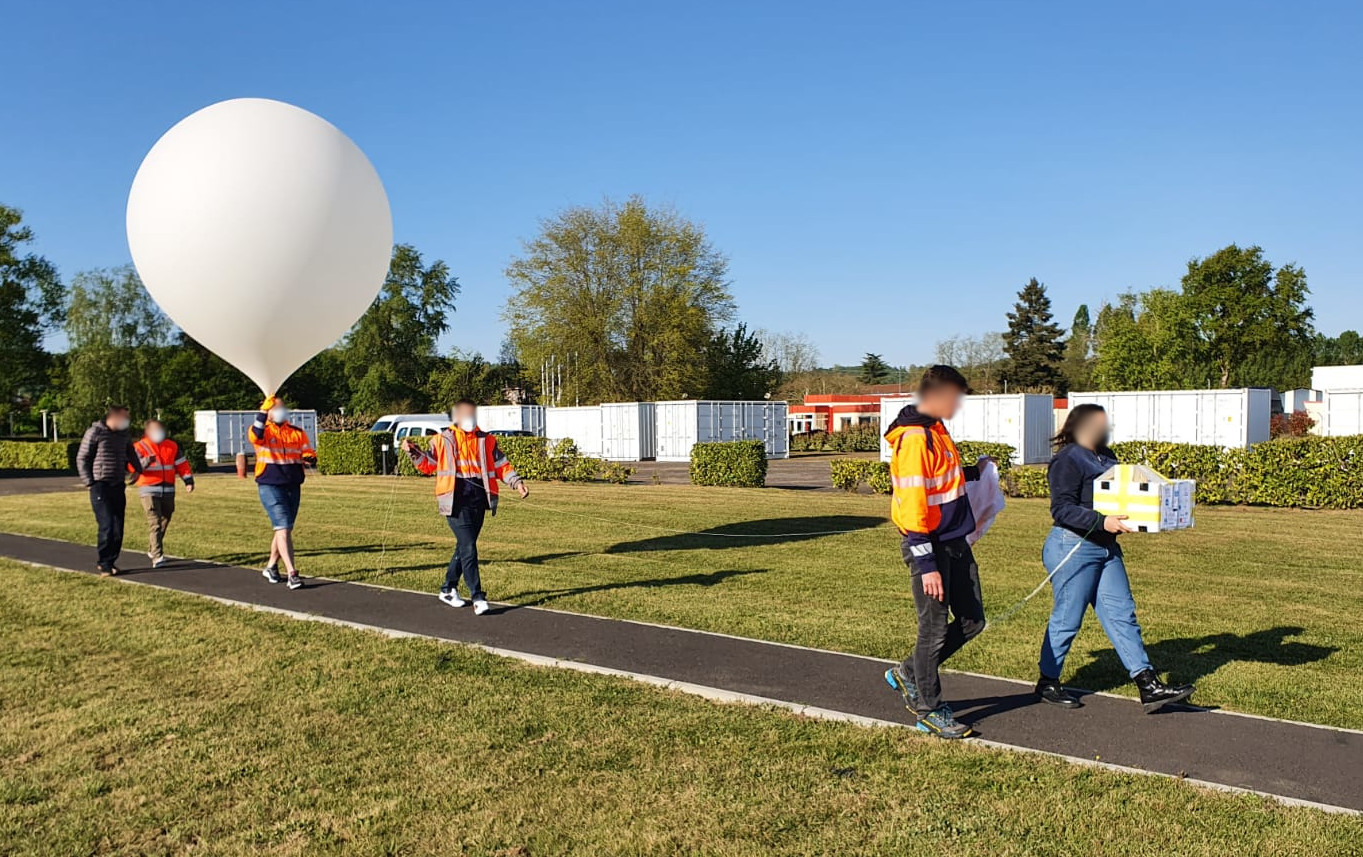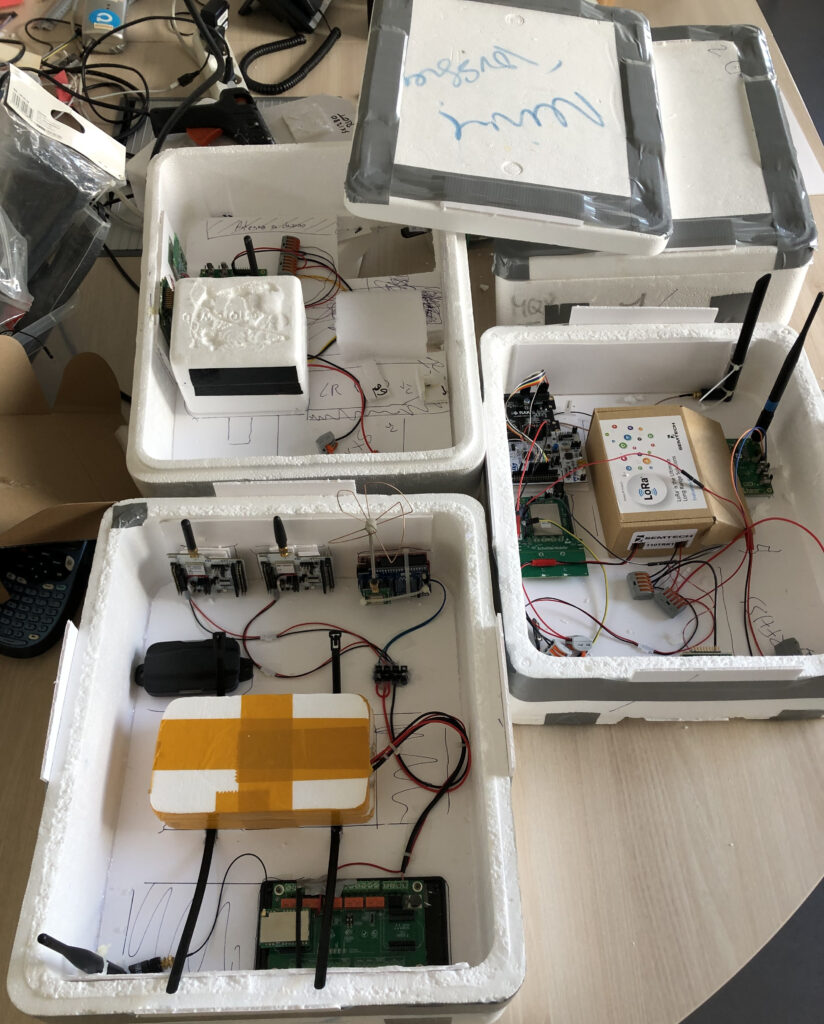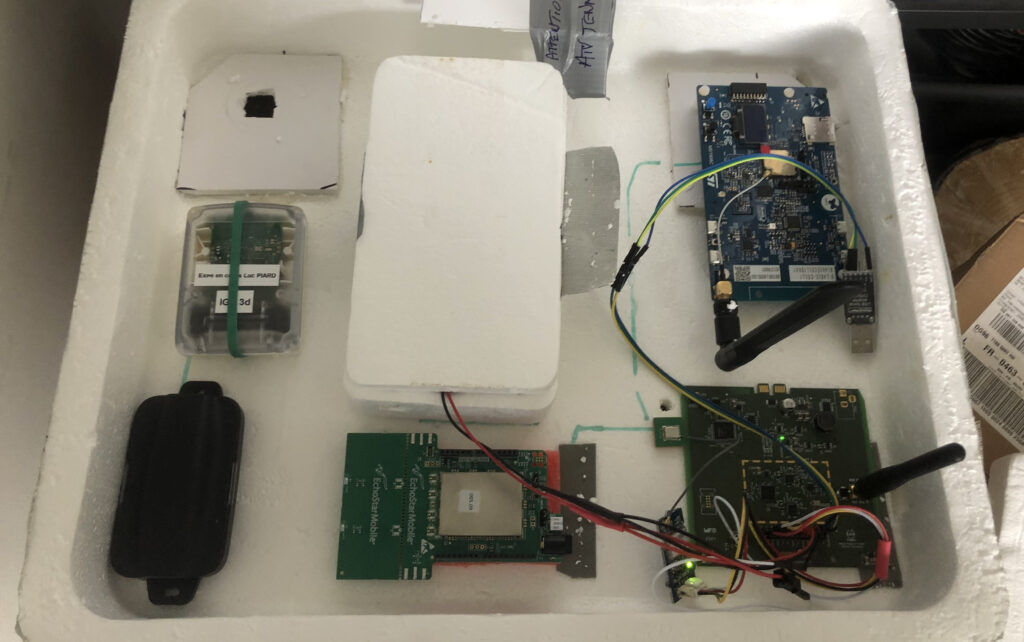
Summary
This article outlines the objectives and methodology for a ground-breaking high-altitude Low-Power Wide-Area Network (LPWAN) high-altitude balloon tracking experiment conducted by the Université Grenoble Alpes in collaboration with an ecosystem of commercial partners, including EchoStar Mobile, Semtech and The Things Network, and the LoRa Alliance® (see partner acknowledgements for full list).
The experiment is designed to test various aspects of LoRa® (Long-Range) and LR-FHSS wireless communication technology at altitudes up to 30 km and across very long distances (> 500 km). However, this article focuses on the specific objective of benchmarking satellite IoT communications for high-altitude balloon tracking, using Echostar Mobile’s LoRa®-enabled IoT network.
By utilising high-altitude balloons equipped with specially designed gondolas to carry LoRa® and LR-FHSS devices, the experiment aims to investigate the signal transmission characteristics and performance of LoRa® networks in extreme atmospheric conditions. Additionally, it will assess the feasibility of integrating satellite connectivity to expand network coverage.
The primary goals are to understand how LoRa® signal strength, network latency, and reliability are impacted at high altitudes and to identify optimal network configurations for enhancing IoT applications. Challenges include signal degradation and equipment endurance at significant altitudes.
The findings from this experiment have the potential to enhance long-range, low-power communication by integrating satellite networks. Potential applications range from environmental monitoring and disaster recovery to complementing GPS in scenarios such as asset and personal tracking. The results will offer valuable insights for researchers, IoT developers, and industry professionals aiming to leverage satellite-enabled LoRa® networks for global IoT connectivity.
Introduction
The rapid growth of the Internet of Things (IoT) has driven the development of Low-Power Wide-Area Network (LPWAN) technologies, which provide long-range, low-power connectivity for distributed devices. Among these, LoRa® (Long Range) stands out for its ability to offer robust communication over several kilometres with minimal power consumption. These capabilities make it particularly suitable for applications in remote monitoring, smart agriculture, and logistics.
High-altitude testing plays a crucial role in understanding the potential of LoRa® by exposing the technology to atmospheric conditions vastly different from those on the ground. At higher altitudes, factors such as reduced air pressure and temperature changes can affect signal transmission and equipment performance. Therefore, these tests provide valuable insights into optimising network configurations.
By bridging the gap between terrestrial LoRa® networks and satellite communication, this initiative has the potential to open new frontiers in IoT connectivity, benefiting industries ranging from disaster recovery to environmental monitoring.
Objectives of the Experiment
In their latest iteration of testing, the Université Grenoble Alpes has launched a pioneering experiment using high-altitude balloons equipped with gondolas carrying LoRa® technology, including IoT endpoints and gateways. This project aims to explore the signal behaviour of LoRa® at various altitudes and in extreme atmospheric conditions while evaluating the integration of satellite IoT services.
Three balloon gondolas will be deployed in this experiment targeting several objectives, including:
- Testing the technology in near-space conditions (vacuum and -60°C),
- Benchmarking LR-FHSS links over very long distances (> 500 km) for EU868 bands (868 MHz)
- Benchmarking LoRa® links over very long distances (> 500 km) for EU868 bands (868MHz) and 2.4 GHz.
- Benchmarking cellular IoT links (NB-IoT) at high-altitude (up to 30 km)
However, this paper focuses on the experiment’s aim of benchmarking satellite IoT communications for high-altitude balloon tracking within the parameters of the objectives noted above and how satellite connectivity can be leveraged to complement terrestrial LoRa® networks for seamless global coverage.
Experiment Design and Methodology
The high-altitude balloon tracking experiment uses specially designed balloon gondolas made from expanded polystyrene to carry a selection of IoT endpoints, antennas and ancillary equipment, such as battery packs. The total weight of the balloon basket must not exceed 2800g. The gondolas will be launched to a target altitude of up to 35,000 metres, taking off at Aire-sur-l’Adour.
The balloon gondolas carry GNSS modules configured in balloon mode and CNES radio sondes, transmitting APRS packets at 404.002 MHz to provide real-time telemetry for accurate tracking and monitoring. Each gondola is equipped with sensors to collect data on temperature, humidity, atmospheric pressure, acceleration, and magnetism, providing a detailed picture of environmental conditions at various heights. In addition, high-resolution 4K sports cameras will capture the flight visually.
Key to the focus of evaluating the performance of satellite IoT communications at high altitude is the Echostar Mobile EVK, which utilises Semtech’s LR-FHSS (Long-Range Frequency Hopping Spread Spectrum) technology coupled with Echostar Mobile’s LoRa®-enabled IoT network. This configuration allows the gondola to transmit data directly to EchoStar’s geostationary satellite, ensuring reliable and uninterrupted communication even from extreme altitudes.
The network configurations also include terrestrial and LoRaWAN networks, such as Orange, The Things Network, Helium Foundation and Requea, to assess seamless data transmission across multiple environments.
Overall, this experiment’s setup will yield valuable insights into the performance of LoRaWAN and satellite IoT networks under high-altitude conditions, informing future IoT network design and implementation.
Key Challenges
Technical Challenges
The high-altitude balloon experiment faces technical challenges like the extent to which LoRa® signals may weaken due to atmospheric interference at extreme altitudes. Noise and environmental factors, including temperature fluctuations, air pressure changes, and strong winds, can also impact signal transmission and the performance of onboard equipment. Durable hardware design is essential to protect the equipment from the harsh environment while providing reliable data transmission. For example, the battery packs must be insulated appropriately to continue working at temperatures of -60°C.
Regulatory Challenges
Maintaining strict compliance ensures the experiment doesn’t interfere with other communication systems while safely navigating controlled airspace. Operating within authorised frequency bands and adhering to local spectrum rules is crucial. Another consideration is the weight of the balloon gondola. Each balloon gondola must weigh less than 2,800 grams to ensure a safe landing that does not cause damage to people or infrastructure.
Expected Applications and Benefits
Potential Applications
The results of this high-altitude satellite IoT experiment could significantly benefit a wide range of fields. For example, the balloon data could enhance weather forecasting and climate research in environmental monitoring by offering more accurate high-altitude atmospheric readings.
Moreover, while high-altitude balloon tracking may not directly apply to everyday logistics and agricultural operations, the experiment provides valuable insights that can benefit these fields. By testing LoRa® signal performance in extreme conditions, this experiment helps optimise long-range communication networks, making them more reliable in rural or remote areas where traditional networks struggle. Such improvements in communication range and resilience can enhance supply chain tracking and precision agriculture, offering consistent connectivity across vast regions.
Furthermore, by complementing GPS with satellite-enabled LoRa® signals, the technology could provide an additional layer of communication that enhances asset or personal tracking in areas with limited GPS coverage. This capability is also valuable in disaster recovery, as such a network can provide rapid, resilient communication for search and rescue teams in areas with disrupted infrastructure.
Industry Impact
The potential for satellite-enabled LoRa® networks to complement terrestrial services and provide seamless global connectivity is immense. This experiment could lay the groundwork for broader adoption in industries where consistent and cost-effective IoT communication is essential. From managing international supply chains to monitoring critical infrastructure and enabling remote healthcare services, this technology may transform how various industries connect and communicate on a global scale. The long-range, low-power advantages of LoRa® networks, integrated with satellite connectivity, offer a powerful solution for those seeking to expand the reach of their IoT networks.
Conclusion and Next Steps
In this high-altitude experiment, Université Grenoble Alpes seeks to assess signal transmission and performance of LoRa® at altitudes up to 35,000 metres, using balloon gondolas equipped with IoT endpoints and satellite connectivity. The objective is to evaluate how atmospheric conditions impact signal strength, range, and power efficiency. By leveraging Echostar Mobile’s LoRa®-enabled IoT network alongside terrestrial networks, the study will provide insights into high-altitude satellite IoT communications to help optimise network configurations for seamless global connectivity.
This high-altitude experiment by the Université Grenoble Alpes represents a significant step forward in understanding how LoRa® signal transmission behaves at extreme altitudes and distances. The findings will provide critical insights into the challenges and opportunities of integrating satellite-enabled LoRa® networks with terrestrial networks to achieve seamless global coverage.
By assessing how atmospheric conditions affect signal strength and network latency, the study will guide researchers and industry professionals in optimising IoT network configurations for long-range communication. These results will ultimately contribute to the development of resilient IoT networks that reach remote regions and are capable of serving industries like disaster recovery, environmental monitoring, and logistics, where uninterrupted connectivity is paramount.
Outline for Part 2
Part 2 will share the results of the high-altitude testing, providing analysis and interpretation of the collected data. It will explore the practical implications of the findings, offering recommendations for improving future IoT applications.
Partner acknowledgements
Thank you to our partners and collaborators for their support and expertise in making this high-altitude LoRa experiment possible:
Université Grenoble Alpes (CSUG, OSUG, LIG, LCIS, CROMA), INSA de Lyon CITI, IMT Atlantique, ANS Innovation, CNES Centre des Opérations Ballons de Aire-sur-l’Adour, REQUEA, Orange, Echostar Mobile, Kineis, Semtech, ChipSelect, Université Clermont Auvergne LPC, Observatoire du Puy de Dôme.




